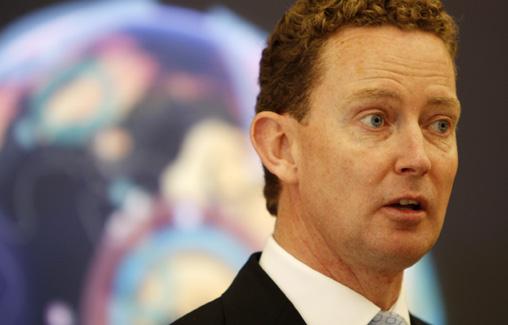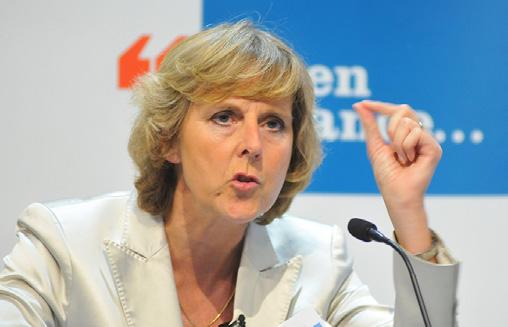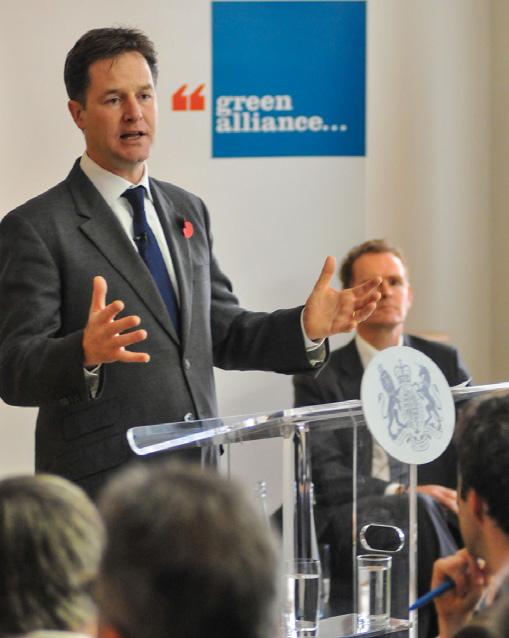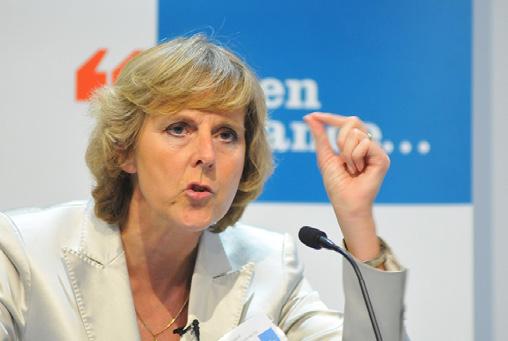Thanks for your new infographic The future of UK infrastructure was really excellent. I hope you don’t mind if people make of it.” Jonathon Porritt, co-founder, Forum for the Future
Without a low carbon infrastructure plan and economic the modern economy you simply don’t have an economic Shadow Chancellor Ed Balls MP, July 2013 Investing in better decision making
* click through
Green Alliance 2013 review
1
2013 review
Highlights 2013
We showed the significant value of low carbon infrastructure to the UK economy.
Page 5
Shadow Chancellor Ed Balls announced at Green Alliance’s summer reception that low carbon infrastructure would be at the heart of Labour’s growth plan.

Page 5
In its electricity market reforms the government acknowledged the case for rewarding electricity efficiency which Green Alliance first proposed in 2011.

Page 13
We interviewed 20 policy experts to conclude that EU climate and energy policy has had a positive impact on the UK; and hosted a major speech by EU Environment Commissioner Connie Hedegaard, on the new EU 2030 policy package.

Page 13
New, high level debate in government about better resource use was stimulated by a major report from the Circular Economy Task Force, convened by Green Alliance.
Page 16
The Deputy Prime Minister Nick Clegg delivered the first major environmental speech by a political leader in the current parliament to a Green Alliance audience in November.

Page 10
There was significant media coverage for the Green Standard in September 2013, published with six major UK environmental NGOs. It analysed the performance of the main parties and challenged their lack of political leadership on the environment.
Page 9
Thirty political thinkers and independent experts, including energy and climate change minister Greg Barker, contributed to our three influential Green Roots essay collections, examining new narratives on the environment for the UK’s main political traditions.
Page 8
Green Alliance 2013 review * click
2
through
Amount of material Impact of material Total impact of material 76t of gold 16991 tCO2/ tonne gold 1,291,316 tCO2 57,456 tCO2 76t of recycled gold 756 tCO2/ tonne recycled gold
Robin Bidwell chair of trustees

We set out on a three year strategy in 2012 to find new models for a greener economy and to invest more in stronger political leadership for the environment.
As this review shows, we are making considerable strides towards these aims, particularly by clarifying the connections between the green agenda and the wider UK economy. Julian Morgan, a macroeconomist of considerable standing, joined us early in 2013 as our new chief economist. His work has addressed the wider benefits of low carbon infrastructure and the effect that resource prices have been having on the cost of living. These analyses supported by excellent infographics have been well received and have promoted debate in the macroeconomic and sustainability communities.
We were pleased that Nick Clegg chose Green Alliance as the home for his speech in November 2013, the first green speech by a party leader in the current parliament. The Shadow Chancellor Ed Balls, EU Environment Commissioner Connie Hedegaard and the Secretary of State for Energy and Climate Change Ed Davey were also among the speakers we hosted at our other events throughout the year.
While much of our success is visible, some of our best work goes on behind the scenes. You may not have heard much about our Climate Leadership Programme’s work with MPs in their constituencies; or about our Green Roots project working with senior figures from the UK’s main political traditions, aiming to develop carbon strategies that fit within their individual political philosophies. But both of these programmes are opening up much needed political space and have the potential to create a favourable working environment for the UK’s green businesses.
This year is the 35th year we have worked to bring together the worlds of business, government and NGOs for a better environment. As the only think tank focused on ambitious UK leadership on
the environment, operating perhaps uniquely with both the left and right of the political spectrum, we are achieving perceptible shifts in the UK’s policy landscape. This year our influence on new energy saving policy and improving the visibility of the circular economy concept are clear and have been achieved by building effective relationships, thorough research and analysis, and shaping policy to fit within the realities of current politics.
Our relationships with businesses go from strength to strength. Eight major businesses are exploring new business models with us in the Circular Economy Task Force; thirteen companies make up our Business Circle, debating current business issues, and our Low Carbon Energy consortium provides us with valuable insights on energy policy.
We couldn’t achieve so much without the collaboration, support and encouragement of the many organisations and individuals we work with, not least our highly valuable partnerships with the UK’s leading environment and development groups and committed companies from the private sector. I would like to thank our supporters, the staff and my fellow trustees for their hard work and inspiration in continuing to press the case for a better, greener UK.
Matthew Spencer director

Politics is a bit like farming in medieval times. It’s hard work, messy and you only have rudimentary instruments, but if you don’t put time into it you’ll definitely go hungry. 2013 was tough for the environment community, because the populism of energy price freezes and fracking fever dominated the political debate.
Despite this we have found ways, working with our partners, to invest in better decision making. Sometimes, as with our Green Roots work with the three political traditions, this is patient investment which may take many years to show a return.
The same could be said of our Circular Economy Task Force, where business thinking on resource stewardship is at least a decade ahead of that of government. Occasionally, we get a surprise and things develop quickly, like when the coalition agreed to push for an EU 50 per cent carbon reduction target for 2030, which confounded those who had expected weak climate leadership from the UK.
However, perhaps the most satisfying result for us was the decision to establish a new UK market for negawatts, two years after we first laid out evidence from the US of how it had avoided the need for new power station investment. It’s early days, but it has the potential to rebalance incentives in the electricity sector radically towards demand reduction, and to create new incentives for energy saving.
The year also brought smaller pleasures, some great events and over 100 good reads on our blog. These reflect the rich conversations we have which keep us all fresh and give us the motivation to invest personal capital in the strange beast we call politics.
Green Alliance 2013 review * click through 3 Introduction
A better economy
We believe that a resilient economy requires new economic and business models; and that low carbon infrastructure, better resource stewardship and the protection and restoration of natural systems are the foundations of a good economy.
4 Green Alliance 2013 review
Robust economic analysis
Shaping the infrastructure debate
In July 2013, our analysis* demonstrated the high proportion of low carbon infrastructure in the government’s pipeline of planned infrastructure projects. We highlighted the significant risk to the UK’s economy if the government waivers in its low carbon commitments and deters investment. The numbers involved were revealed in an infographic,* which showed that planned low carbon infrastructure projects are worth four times the value of high carbon projects to the economy and that, in 2011, the green economy was employing the same proportion of the UK work force as the iron and steel industry at the height of the Industrial Revolution.
Shadow Chancellor Ed Balls and Financial Times chief economic commentator Martin Wolf debated the future of UK infrastructure at our summer event in July 2013. Martin Wolf said there was a clear case for an investment stimulus to the economy and it should have green investment at its core. Ed Balls supported our analysis and committed to putting low carbon development at the heart of Labour’s growth plan and to re-establishing European leadership on climate.*
New expertise
Our chief economist, Julian Morgan, joined us in April 2013. An experienced macroeconomist, previously at the European Central Bank and the government’s economic service, Julian is adding a new analytical dimension to our work. This role was established with the kind support of the Esmée Fairbairn Foundation.
about our event with Ed Balls on Storify Watch a short video clip of Ed Ball’s speech


5 Green Alliance 2013 review
“Thanks for your new infographic The future of UK infrastructure. I thought it was really excellent. I hope you don’t mind if people make good use of it.”
Jonathon Porritt, co-founder, Forum for the Future
“Without a low carbon infrastructure plan and economic strategy, in the modern economy you simply don’t have an economic plan.”
Shadow Chancellor Ed Balls MP
“30 years of debt fuelled, consumption led growth, prior to the crash, can hardly be a model for the future. Investment in the right type of infrastructure, which supports the transition to a low carbon, resource efficient economy, can be the cornerstone of a new growth model.”
Low carbon 205,206 Carbon neutral 44,321 High carbon 38,215 * Read Infrastructure investment and the UK’s economic renewal See the infographic The future of UK infrastructure
Julian Morgan, Green Alliance chief economist
The largest infrastructure projects in the UK are low carbon, from The future of UK infrastructure (July 2013)
Read more
Improving understanding of the green economy
In the summer of 2013 we called on the Office for National Statistics (ONS) to provide better statistics on the green economy. In the autumn it announced it would and our chief economist has contributed to the review.
The UK’s position in the global green market
Twelve major businesses collaborated on our Business Circle foresight report The global green race* showing the extent of competitive risks to the UK’s low carbon sector. It highlighted the companies’ concerns about the UK’s worsening policy environment in the face of global competition. We recommended accelerating low carbon infrastructure projects; redirecting R&D spending to create a green venture capital fund; and focusing on commercialising those technologies where the UK has world leading expertise.
* Read our report, The global green race
6 Green Alliance 2013 review
“The UK has had some success, but we can’t be complacent. There needs to be a stable, coherent strategy –supported by all parts of government – to maintain our green competitive edge. We’re talking big stakes: £60 billion of domestic low carbon projects in the pipeline, growing export orders and a chance to develop valuable new energy technology markets, such as in offshore wind, marine power, CCS and electricity storage.”
Brazil China £232m £140m £794m £412m £331m £291m £358m £229m £189m £170m £211m £464m Green imports 2010-11 Green exports 2010-11 India USA UK Germany Japan
Terence Watson, president, Alstom UK
Companies in green business sectors are major exporters, generating a surplus for the UK with every country we trade with, from The global green race (August 2013)
The global green race: a business review of UK competitiveness in low carbon markets
Better political leadership
We aim to embed green thinking more deeply into UK politics, so a greener economy is seen as a critical objective for good government.
7 Green Alliance 2013 review
A pluralist, non-partisan approach to politics
New political narratives on the environment
In 2012 we launched Green Roots,* an ambitious project working with the leading thinkers from the UK’s three main political traditions on their approaches to the environment.
Under the three strands: Green conservatism, Green social democracy and Green liberalism, we’ve worked with senior politicians, political thinkers and academics to identify fresh environmental narratives that resonate with each political tradition.
The three Green Roots essay collections,* published in September 2013, reflected topical concerns: conservatives discussed how to protect the environment through open markets; social democrats focused on the importance of creating better places for communities; and liberals explored ideas around a local approach to developing a low carbon economy.
With forewords by Ed Miliband, Nick Clegg and Lord Howard, these collections help to demonstrate the fundamental importance of green thinking to all the parties, not always visible in daily politics. We hosted discussions around the themes at each of the party conferences and more buzz was created when some of the essays were published on the leading political networking blogs: Conservative Home, LibDem Voice and LabourList.
approach to
*
Find out more about Green Roots
Read Green conservatism: protecting the environment through open markets
Read Green social democracy: better homes in better places
Read Green liberalism: a local approach to the low carbon economy

8
“It is by unleashing competitive market forces that we will find the most efficient and innovative ways to resolve environmental issues.”
Dan Byles MP, from Green conservatism: protecting the environment through open markets
“Liberalism is not only compatible with environmentalism, it requires an environmental approach.”
Duncan Brack, Liberal Democrats Federal Policy Committee, from Green liberalism: a local
the low carbon economy
“We will reflect on these suggestions as we set out our policies for the general election.”
Rt Hon Ed Miliband, from Green social democracy: better homes in better places
“The work Green Alliance has been doing with fellow Conservative parliamentarians is hugely valuable, helping to inform and drive forward the environmental agenda on the centre right.”
Rt Hon Greg Barker MP, minister of state for energy and climate change
Green Alliance 2013 review
Challenging the parties on their green performance
Working with six of the leading environmental NGOs in the UK, we produced The Green Standard 2013,* ahead of the party conferences in September. This was a thorough assessment by all the groups of coalition and shadow ministers’ performance on green issues since the 2010 general election. We looked at four key areas: the economy, communities, nature and international leadership, and found that, while some individual politicians had done well, overall none of the parties had a coherent programme, and no party leader had demonstrated effective leadership on the environment.
A review of UK political leadership on the environment since the 2010 general election

GREEN STANDARD 2013

“Seven charities including RSPB, Greenpeace and WWF have combined forces to give a largely damning verdict on all three of the big political parties.”


The Independent, 13 September 2013*
“Lib Dems accused of environment failure”

The Times, 13 September 2013*
“UK’s main political parties have ‘failed to show leadership on environment’’
The Guardian, 13 September 2013*
*
Read The Green Standard 2013
Read the article in The Independent
Read the article in The Times
Read the article in The Guardian
9
“Given that our leaders recognise that we’re in a global race to develop environmentally sustainable economies, it’s in their interest to show environmental leadership.”
David Nussbaum, chief executive, WWF UK
Green Alliance 2013 review
First Green Alliance Leadership Lecture by the Deputy Prime Minister Nick Clegg
Nick Clegg set out his party’s approach to the natural environment, energy bills and the green economy at Green Alliance’s first Leadership Lecture* in November 2013. It was the first green speech by a party leader in the current parliament. Describing it as one of his “most important speeches of the year”, he used it to reassert the Liberal Democrats’ commitment to the green agenda and announced government support for the development of ultra low emission vehicles and a new pollinator strategy for bee protection.
A stronger UN framework for development
Climate change, natural disasters, ecosystem decline and biodiversity loss are all huge risks to sustainable development and especially to the world’s poorest communities. In 2013 the UN’s High-level Panel on post-2015 development, was agreeing the framework for the future. It was co-chaired by Prime Minister David Cameron, seen above with the panel’s chair, President Yudhoyono of Indonesia.

With Christian Aid, Greenpeace, RSPB and WWF, we outlined four environmental resilience tests for the framework,* which we discussed at meetings with the prime minister’s adviser. The tests focused on environmentally resilient poverty reduction; resource efficiency and security; secure, clean, sustainable energy; and effective disaster risk reduction.
The influence of our work was clear when, in May, the final report from the High-level Panel pledged to put sustainability at the heart of the UN’s post-2015 development framework.
“A key objective of the coming years will be to ensure that international development goals for poverty reduction and our low carbon and environmental commitments are aligned. Our joint report on environmental resilience in the post-2015 development framework was an important contribution to meeting this global challenge and ensuring that the High-level Panel, which David Cameron cochaired, had sustainability front and centre.”
chief
*
See more about Nick Clegg’s lecture on Storify Read Eradicating poverty through environmentally resilient development

10
“Today I want to make it very clear that my commitment to the green agenda is as strong as it ever was, and it will stay that way.”
Deputy Prime Minister Nick Clegg
Green Alliance 2013 review
Loretta Minghella,
executive, Christian Aid
Supporting climate leadership by MPs




Since 2009 our Climate Leadership Programme has helped more than 50 MPs to develop better understanding of climate change and what it means for them at constituency and national levels. The new phase of the programme in 2013, ‘Constituency Voices’, involved MPs and local stakeholders in cross party groups, on issues in constituencies relevant to the low carbon agenda.
In July we focused on the potential for developing the low carbon economy through city deals. Conclusions from our workshops with Chris White, MP for Warwick and Leamington, Alex Cunningham, MP for Stockton, and Robert Buckland, MP for Swindon, were fed back to the government.*

In August 2013, workshops with the MPs Paul Blomfield, Tessa Munt and Mike Crockart were held on issues around community energy. The results* contributed to the government’s consultation on community energy. We reported that communities were ‘demoralised and obstructed’ by a lack of clear policy and barriers to finance for projects. Our recommendations included the need to strengthen national policy with a clear vision for the future of community energy and to make schemes like the renewable heat incentive (RHI) more effective.
*
Read Consituency voices: greening city deals
Read Consituency voices: realising the potential of community energy

11
Green Alliance 2013 review
“There is a real interest in community energy in my constituency, but complex and risky development processes are making it harder than it should be. This shouldn’t be happening – we should be actively encouraging these projects and making it easy for a community group to realise their ideas.”
Paul Blomfield, MP for Sheffield Central
Chris White, MP for Warwick and Leamington
Alex Cunningham, MP for Stockton North
Paul Blomfield, MP for Sheffield Central
Robert Buckland, MP for Swindon South
Tessa Munt, MP for Wells
Mike Crockart, MP for Edinburgh West
Better energy policy
We are working with leading businesses and NGOs on the infrastructure and innovation needed to decarbonise the UK’s energy system, the biggest investment challenge of our age.
12
Green Alliance 2013 review
Keeping UK decarbonisation on track
Assessing the impact of EU climate and energy policy
The door opens for negawatts
Since 2011 we have concentrated on influencing government reforms to the electricity market,* and we’ve pushed for better policy on energy saving. As a result of the case we made the government take the significant step to include investment in reducing electricity demand, as well as supply, in its plans for the capacity market. There is still some way to go, but the first incentive scheme, in the form of a pilot for negawatts, will be in place from June 2014. We are now focusing on well designed financial incentives for electricity saving.*
“We welcome the fact that the government has acknowledged the case for rewarding electricity efficiency. Green Alliance first proposed this idea two years ago, based on evidence from the US, and we congratulate Ed Davey and Greg Barker for getting government support for an amendment to the Energy Bill. ”
Matthew Spencer, director of Green Alliance, May 2013
In 2013 the EU began discussions about the 2030 climate and energy policy package, which will be finalised in 2014. Showing the positive impact of past policies, we have made the case for ambitious European climate and energy policy after 2020. Influential businesses, trade associations and energy experts all supported strong EU policy in a survey for our report What has EU climate and energy policy done for the UK?. This was heavily quoted in the government’s Review of the balance of competences on environment and climate change in February 2014.
The EU environment commissioner, Connie Hedegaard, was the main speaker at our October debate about EU 2030* policy, attended by energy experts and business. We also presented our analysis and proposals for a strong policy package.*
In line with our recommendations, the UK has stated that Europe should commit to a 50 per cent greenhouse gas reduction target for 2030. We are now working with NGOs and businesses to encourage the government to stick to this commitment as well as urging other member states to adopt the target.
£102
@CamCavendish Chaired fascinating @GreenAllianceUK debate yesterday on #eu2030. Camilla Cavendish, associate editor at The Times @NickMolho
£19
Annual lighting cost per UK household, from What has EU climate and energy policy done for the UK? (October 2013)
Read about our 2013 event on electricity market reform Find out more about our ideas for financial incentives for electricity saving Read about our event with Connie Hedegaard on Storify

Read What has EU climate and energy policy done for the UK?
See our presentation Getting EU climate and energy policy on track
13
#climate change risks are no longer an environmental issue, they’re an economic one says @CHedegaardEU #EU2030
Green Alliance 2013 review
Nick Molho, head of climate and energy policy, WWF UK
*
Switching the UK onto heat pumps
As heat is responsible for a third of carbon emissions and around half of the energy used in the UK, it is widely agreed that something has to be done to reduce the impact of heating. All future scenarios suggest that low carbon heat pumps should be a much more commonly used technology. But they are a long way from mass market acceptance. In May 2013, our online presentation* unravelled the complexities and demonstrated simply the main issues around heat pumps and their potential. It showed the need to improve their reputation and for better regulation, to encourage uptake and achieve wider roll-out across the UK. This presentation has had over 3,000 views.
Seven steps to reducing energy bills
High energy bills have been a major factor behind the UK’s cost of living crisis. In December we identified the seven steps government should take* to increase levels of home energy efficiency retrofit and reduce fuel poverty. This work was supported by Scottish Power, Carillion and Rockwool. Ben Webster in the The Times highlighted our finding that over half a million homes were losing money because of delays to government subsidies.
*
See Switching the UK onto heat pumps
Read Seven steps to reducing energy bills

14
“Delays in insulation subsidies ‘are leading to higher fuel bills’”
Green Alliance 2013 review
The Times, 2 December 2013
Seven steps to reducing energy bills how energy efficiency retrofit can help tackle the cost of living crisis
Better resource use
We believe that effective resource stewardship is critical for resilient economic development within environmental limits. We work to influence public policy and business practices to ensure a greater emphasis on stewardship and circularity in the use of resources.
15
Green Alliance 2013 review
Making the circular economy work
The Circular Economy Task Force
Resource resilient UK
A report from the Circular Economy Task Force

The benefits of landfill bans
In 2013 Labour supported an energy bill amendment, to ban biodegradable waste from going to landfill. This was influenced by our infographic Why we need landfill bans* which showed the economic potential of keeping certain materials out of landfill.
New work with Scotland and Google
New Green Alliance projects* on the circular economy include work with the Scottish government on areas relevant to Scotland’s economy; looking at the wider effects of resource prices on the economy; and, in a new project with potential for great impact on a specific sector, we are working with Google to analyse how laptops, tablets and mobile phones can be made more circular.
Landfill bans for mobiles make recycling happen
No landfill ban
92% to landfill
The USA threw away 141m mobile devices in 2009. 92% of them went to landfill. The USA doesn’t have landfill bans.
Landfill bans get more value from old cars
Landfill ban now 25% recovered
The UK recovered nearly three times more mobiles than the USA in 2010,2 due to WEEE regulations.3
Landfill ban in the future
80% recovered
By 2020, the UK will recover 80% of mobiles, keeping £13m of value in the economy per year.
No landfill ban
Landfill and dumping cost £88m
In 2003, 25% of cars were landfilled and over 230,000 cars were abandoned in the UK. 4
Landfill ban now
Better recycling collection saved £29m in 2008
EoLV regulations limited landfill from 2004. 2006, they required collection.5
In 2012 we launched the Circular Economy Task Force,* including WRAP and seven major businesses, to explore ways to establish systems for extensive reuse, remanufacturing and secondary material supplies in the UK.
The Task Force’s first year report, Resource resilient UK,* published in July 2013, analysed the ‘circular’ potential of different materials. It proposed that government industrial strategy and regulation should help businesses to collaborate, set sector-wide goals for recovery and develop new, resource efficient business models. The winter 2013 edition of our journal Inside Track* featured a range of perspectives on making a circular economy a reality, including those of Unilever, Defra and the McKinsey Global Institute. This work has opened up an important new channel for discussion between government and business and, in its second year, the Task Force is looking at what scale circular business models in the UK need to operate.
*
Read more about the Circular Economy Task Force
Read Resource resilient UK
Read the winter 2013 issue of Inside Track magazine
See our infographic Why we need landfill bans
Read more about our work with the Scottish government and Google
Find out more about our work on resource price shocks
16
“The calibre of thinking and analysis by Green Alliance on the circular economy has been outstanding. Coupled with action oriented engagement with policy makers through the Task Force, it’s now in a powerful position to influence change.”
Green Alliance 2013 review
Ramon Arratia, European sustainability director, Interface
landfill_infographic_AW.indd 6
Good thinking External commentators give their views via the Green Alliance blog and in our journal Inside Track
Inside Track 32, Spring 2013 Cities: the new green entrepreneurs
“The big idea is not a single mono-manic project but, rather, an overarching vision with landscape as the primary infrastructure.”
Sir Terry Farrell, urban designer and architect, on the development of the Thames Estuary

“Cities … offer the best means to rapidly develop, test and replicate sustainability solutions around the world”
Chris Guenther of SustainAbility, on the positive role of cities


Inside Track 33, Winter 2013 Resource resilient UK
“The means are available to create a resource productivity revolution on a similar scale to the transformational changes in capital and labour productivity witnessed during the 20th century.” Fraser Thompson of the McKinsey Global Institute, on improving resource productivity
“We’ve set ourselves the goal of halving the waste associated with the disposal of our products by 2020.” Louis Lindenberg of Unilever, on his company’s plans to reduce resource use.

Green Alliance 2013 review * Read these and other issues of Inside Track 17
10 Inside Track 11 Issue 32 Spring 2013 of this nature. Here, in this 80 kilometre long estuary, the big idea is not single mono-manic project but, rather, an overarching vision with landscape as the primary infrastructure; one that is fundamental to creating sense of place and feeling of belonging. If this vision of coherent, connected landscape the picture on the box, then the pieces of the puzzle are the myriad regional, local and community schemes that the public, private, and civic sectors are already beginning to realise. There have been many attempts to provide greater spatial connection. The Thames Gateway proposals, under the former Deputy Prime Minister John Prescott, precipitated joining up of planning activity across the region with one result being the Thames Estuary Parklands initiative. The focus on the region’s green infrastructure, its green spaces and rivers, was vital to ensure new development was sensitive to its context. As put so much emphasis on landscape as the primary infrastructure, was heartened by the government’s recent announcement that the Thames estuary to be one of 48 local nature partnerships (LNPs) established across England. have always passionately believed that regeneration of the Thames estuary should begin with the landscape, its most outstanding and unifying feature. Long recognised by poets, painters and writers, including Hopkins, Turner and Dickens, the estuary natural and beautiful landscape of wetlands, marshes and mudflats, landscape of sufficient quality compare with the national parks. The ambition for LNPs is that they will help to manage the natural environment as holistic system, embedding its value in local decisions for the common benefit nature, people and, not least, the economy. To do this, they will need to be self-sustaining strategic partnerships of broad range of local organisations, businesses and people, with the credibility and, indeed, clout to work with and influence other local decision makers. Effectively the Thames Gateway LNP will crystallise the partnership working that has already been quietly taking forward both the vision and the reality of the Thames Estuary Parklands initiative. What is not widely understood how much progress there has already been on the ground, with great strides being made in transforming the perceptions of place and the quality of life. All over the estuary, new, high quality landscapes such as Erith Marshes and the Dagenham Washlands are being created, which will have lasting impact on the environmental, social and economic potential of the region. These initiatives, whether macro or micro, are slowly but surely contributing to connected landscape infrastructure, network of strategically planned, high quality green spaces and other environmental features. Over time it will meet the eastward extension of the excellent Green Grid planning initiative in east London by the GLA and Design for London. The broad political concord about the vision is striking. see the choice of the Thames estuary as one of the first LNPs as recognition of this, and as soundly based vehicle for the holistic vision, informing and guiding hundreds of local interests. reflects the balancing of demands of the broader region while ensuring that natural qualities continue to shape the opportunities for the future. Sir Terry Farrell is renowned urban designer and architect. He is the design adviser to the Mayor of London and design champion for the Thames estuary. www.terryfarrell.co.uk London under immense stress, with the Greater London Authority (GLA) predicting, and planning for, another 1.25 million people living in the metropolis by 2031. That’s an additional population the size of Birmingham. Even with the regeneration of these post-industrial corridors, space in London is getting scarce and its infrastructure is under increasing strain. With the highest return on investment for public and private sectors, and the highest gross value added (GVA) per capita, growth in London and the greater south east is critical to the UK’s future prosperity. But where the space for this growth to happen? And how can we create the infrastructure that needs in sustainable and resilient way? The answer is to rediscover and re-evaluate the natural order that underlies London. London has long had symbiotic dependence on the Thames and its tributaries, as natural providers of food, transport, and power, as conduits for waste and sewage and, last but not least, as routes out to the countryside. Today, London ever more reliant, socially, physically and economically, on the Thames estuary for this complementary natural infrastructure. An integral, downstream part of the metropolis, the estuary has gradually been reclaimed from the sea and where true globalisation started: navigation and exploration of the world began in places like Greenwich, Woolwich and Chatham. The large docks, once located in east London, gradually moved out along the Thames to Tilbury and Medway. The Thames estuary has been the engine room of London. place where waste discharged and power generated. Almost ten per cent of the nation’s power is still generated here. Centuries of place based economic activity has united into coherent human landscape. The estuary has the region’s greatest potential, with its open green spaces and natural features and a local appetite, amongst unitary and county councils, to invest in and deliver sustainable economic growth. Along the Thames, from Tower Bridge through east London and onwards downstream, am convinced that place-making, or making somewhere with distinct identity, is the key to this transformation. With least 1.5 million people living in rich and diverse constellation of places, we must recognise the importance of this diversity, and support their growth and regeneration. This coherence provides basis for strong economic rationale for the future. The region supports successful economic sectors, including business and financial services, particularly in east London with major potential for new environmental industry: the London Array windfarm alone will provide enough sustainable power for 750,000 homes. There much inward investment, with built and planned new infrastructure: from the Jubilee line and Docklands Light Railway, to the Channel Tunnel Rail Link, and with Crossrail and maybe another airport on their way. And there extensive brownfield land in accessible locations support new infrastructure. The first ship has already docked at the major new port at London Gateway, with full opening by the end of this year. There is more potential for growth than in the pressured centre of London, in existing and new communities and in commercial centres, all within high quality, biodiverse landscape. By basing growth and regeneration around these assets, the perception and economic prospects of the Thames estuary can be transformed. am often asked what the ‘big idea’ when questioned about vision The big idea is not a single mono-manic project but, rather, an overarching vision with landscape as the primary infrastructure” Sir Terry Farrell offers his vision for the development of the Thames estuary
Inside Track Issue 33 Winter 2013 prices of corn and oil, since autumn 2007 there has been very strong correlation. As the ethanol industry has become the marginal user of corn, the break even prices of ethanol production have set floor price for corn. Another example higher oil prices driving up the prices of synthetic products that use oil feedstock, such as rubber and nylon fibres, which, in turn, putting upward pressure on natural rubber and cotton prices. In the years ahead, resource markets will be shaped by the race between emerging market demand and the need to increase supply from places where the geology more challenging; they will also be affected by the twin forces of supply side innovation and resource productivity. The demand story is relatively familiar but have we really appreciated its scale? Recent doubts about the longevity of rapid growth in emerging markets need to be put into long term context. China’s economy is growing ten times as fast as the UK economy did during its Industrial Revolution and with 100 times as many people. India, too, continues its rapid development. This means surging demand for mineral resources to finance construction booms and increasing car ownership, to name but two effects. We expect the global car fleet to double to 1.7 billion vehicles by 2030. More than 60 per cent of natural rubber is used for tyres, which goes long way toward explaining the 350 per cent rise in the rubber price between 2000 and 2013. The growing electric vehicle market could boost demand for minerals neodymium and lithium by between 120-fold and 200-fold. Rising incomes in these two emerging market behemoths are also fuelling demand for agricultural raw materials, higher incomes mean more expensive food with higher nutritional requirements. In India, we expect calorie intake per person to rise by 20 percent over the next 20 years, and China’s per capita meat consumption could increase by 40 per cent, which would still be well below US levels. With the exception of the shale gas revolution in the US, the supply of energy, minerals and even agricultural raw materials generally becoming more complex, challenging and costly. This means that supply appears to be progressively less able to adjust rapidly to demand. Increasingly, reserves of natural resources are found in difficult places: deep underground and deep underwater for instance. Twenty four per cent of offshore oil wells are now in deep water, compared with 19 per cent in 2005. The richest untapped mineral reserves are mostly in frontier economies that have little infrastructure and are often not politically stable. Almost half of new copper projects are in countries with high degree of political risk. The supply of arable land is increasingly under strain, too. Urbanisation, global phenomenon, could encroach on an estimated two million hectares of land year, about three quarters of which is agricultural land. That means the land left to cultivate tends to be further from markets and on poorer soil. These developments are only exacerbated by the impact of extreme weather events. McKinsey has estimated that more than one fifth of the world’s arable land is seriously degraded from pollution, soil nutrient mining and salinisation. Different studies offer wide range of estimates for the impact of climate change on agricultural yields, but we take conservative estimate that yields could be two per cent lower as result by 2030. Technology has ridden to the rescue before and the shale gas revolution shows can in the modern era, too. There no shortage of resource technology, and higher resource prices are likely to be catalyst for faster innovation. Technology could transform access to both resources and productivity. For example, 3D and 4D seismic technology could significantly improve energy exploration, while organic chemistry and genetic engineering could foster the next green revolution. The means are available to create resource productivity revolution on similar scale to the transformational changes in capital and labour productivity witnessed during the 20th century. Previous McKinsey Global Institute research has identified resource productivity opportunities worth over $3 trillion, which could reduce demand for land, minerals, water, and energy by over 20 per cent in 2030. Just 15 types of opportunity, from improving the energy efficiency of buildings to moving to more efficient irrigation, could deliver about three quarters of the prize. However, capturing such resource productivity opportunities will not be easy. Only about third of the opportunities are readily accessible; many others face barriers including large capital requirements, principal agent issues, and information failures. The key question is whether policy makers and businesses can implement measures fast enough to achieve soft landing of stable or gradually declining resource prices and reduced environmental risk. If they are too slow to seize the opportunities and the world experiences hard landing, characterised by period of very high and volatile resource prices, this would place even greater pressure on the world economy time when facing strong headwinds. The race on. Fraser Thompson senior fellow at the McKinsey Global Institute Reports of the death of the resources supercycle, which saw sustained and rapid rise in commodity prices, have been greatly exaggerated. Although prices have fallen since their previous peaks in 2011, on average commodities now cost nearly as much as they did in 2008, before the global financial crisis hit, despite the fact that the world economy is still not back to full strength. Not only are prices near to their all time highs, they are also increasingly closely correlated. While rapid growth in demand for resources from China has been an important driver of these increased links, at McKinsey we think there are two other important reasons. The first that natural resources account for substantial share of the input costs of other commodities. For instance, energy accounts for between 15 and 30 percent of the cost of producing crop and between 25 and 40 per cent of the cost of making steel. Future changes in prices and production processes could continue to compound these linkages. For example, more complicated drilling methods, such the horizontal drilling used to exploit unconventional oil and gas reserves, can require four times the amount of steel traditional vertical drilling. Second, technology has actually enabled more substitution between resources. The most obvious example biofuels. Higher energy prices have encouraged the use land for energy production. This means that, while in the past there was barely any correlation between the The supply of energy, minerals and even agricultural raw materials is generally becoming more complex, challenging and costly.” The means are available to create resource productivity revolution on a similar scale to the transformational changes in capital and labour productivity witnessed during the 20th century.” The race is on Fraser Thompson asks if we can act fast enough to improve resource productivity
The Thames estuary: London’s green engine room
“The old energy architecture –large scale fossil and nuclear power stations at the centre of a monolithic, analogue and over engineered grid – is no longer the most effective or efficient way of meeting our energy needs.”
‘Avoiding an energy civil war’
Michael Liebreich, 1 October 2013

“Our liberalised system has failed in three crucial areas where the Danes and others have succeeded: innovation, diversity, and engaging individuals.”
‘The co-operative energy sector could be worth £6bn, if the system wasn’t stacked against it’
Rebecca Willis, 28 March 2013

“Climate change comes in as part of the agenda of the cosmopolitan elite (and even worse, the European elite), who are the underlying target of people’s anger…Parts-permillion and a six degree world may strike fear into the hearts of those in the environmental community, but they are just words (and weasel words at that) to populists.”
‘What’s the link between the rising tide of populist politics and climate denial?’
Dr Matthew Lockwood, 15 May 2013


“I suspect about 75p of every pound spent on green initiatives, roundtables, conferences, rankings systems, publications and reports in Britain would be more usefully spent grappling with the emerging giants’ challenges from a political and corporate perspective.”
‘One of the best things an environmentalist can do: get on a plane’
Brendan May, 22 October 2013
Green Alliance 2013 review * Go to the Green Alliance blog 18 Blog
Funding and partnership







The organisations below have supported individual Green Alliance projects and programmes in 2013
Circular Economy Task Force Low Carbon Energy Consortium














19 Green Alliance 2013 review
Cecil Pilkington Charitable Trust
THE ScHrodEr FoundaTion
Green Alliance’s work benefits from productive relationships with many leading companies. Many of our projects benefit from business input. For more than 20 years, the Green Alliance Business Circle has brought companies from different sectors together, to share views on current policy debates and issues they have in common, and to support our business foresight work.





20 Green Alliance 2013 review
Business Circle
Partnership with NGOs



Our longstanding relationships with the UK’s leading environment and development NGOs have been vital to achieving political progress on the environment. Working with them to co-ordinate joint political advocacy, we have helped to communicate clearer, more powerful messages on both the national and international agendas. In 2013, examples of our projects in partnership with other groups included The Green Standard report into party performance, research into the UK’s low carbon infrastructure and joint collaboration on setting environmental resilience tests for the UN’s post-2015 development framework.



21
Green Alliance 2013 review
Green Alliance members
Individual
Jamie Abbott
John Adams
John Alker
Dr Amal-Lee Amin
Rosie Amos
Catherine Andrews
Tim Ash Vie
Anne Ashe
John Ashton
Robert Atkinson
Alison Austin OBE
Dr Mark Avery
Bernadett Baracskai
Janet Barber
David Barker QC
Alison Barnes
Phil Barton
Clive Bates
Lord Bath
Alex Belsham-Harris
Toby Belsom
Terence Bendixson
Nick Bent
David Bent
Lord Berkeley
Dr Robin Bidwell CBE
Sean Birch
Jennifer Bird
Dr John Blunden
Ronald Blythe
Dr Stephen Bolt
Duncan Brack
Tim Branton
Zoe Bremer
Steffie Broer
Chris Brown
Gayle Burgess
Tom Burke CBE
Kate Burningham
Roger Burton
Sarah Burton
Rachel Butterworth
Danielle Byrne
Rupert Callingham
Lord Cameron of Dillington
Mark Campanale
Shaun Carr
Thea Cassel
Pamela Castle OBE
Harry Chichester
Maureen Child
Giles Chitty
Chris Church
Dr MJ Clark
Roger Clarke
Aaron Clements-Partridge
Clare Coffey
Lindsey Colbourne
Yolanda Collins
Tony Colman
Tim Cordy
Martin Couchman OBE
Paul Court
Roger Cowe
John Cox CBE
Roger Crofts
Kate Davies
Lady di Pauli
Hannah Dick
Julie Doyle
Stephanie Draper
Christine Drury
Jane Durney
Mairi Duthie
Joshua Eldridge
John Elkington
Louise Ellaway
Penny Evans
Louise Every
Dr Nick Eyre
Bill Eyres
Nigel Farren
Malcolm Fergusson
David Fitzsimons
Julie Foley
Catherine Fookes
Tim Foxon
George Franklin
Justin French-Brooks
Ray Georgeson
Martin Gibson
William Gillis
John Gordon
Matthew Gorman
Paolo Grasso
Dr Tony Grayling
David Green
Prof Michael Grubb
Nigel Haigh OBE
Paul Hamblin
Tony Hams OBE
Emilia Hanna
Katharine Harborne
David Harris
Helen Harris
Sir Peter Harrop
Nick Hartley
Lord Haskins
Dr Paul Hatchwell
Sir Tony Hawkhead
Dirk Hazell
Lucinda Hensman
Barbara Herridge
Adam Herriott
Henry Hicks
Roger Higman
Julie Hill MBE
Dr Mayer Hillman
David Hirst
Mark Hodgson
Paula Hollings
Stuart Housden
Alex House
Catherine Howarth
Rupert Howes
Richard Howitt MEP
Jim Hubbard
Robert Hull
David Hutchinson
Robert Hutchison
Merlin Hyman
Prof Tim Jackson
Laura Jackson
Julian Jackson
Michael Jacobs
Becky James
Lord Jay of Ewelme GCMG
Alex Jelly
Prof Nicholas Jenkins
Deborah Joffe
Stanley Johnson
Terry Jones
Terence Jones
Claire Jones
Prof Andrew Jordan
Tristram Keech
Angela King
Jean Lambert MEP
Pippa Langford
Nicola Leahy
Jeremy Leggett
Dr Paul Leinster CBE
Hywel Lloyd
Jack Lofthouse
Adrian Lovett
Robert Lowson
Chantal Lyons
Simon Lyster
Ian MacArthur
Eleanor Mackay
Dr Tom Macmillan
Prof Richard Macrory
Prof Aubrey Manning
Mark Mansley
Lori Marriott
Mari Martiskainen
Adam Matthews
Deborah Mattinson
Ed Mayo
Robert McCracken QC
Prof Jacqueline McGlade
Kayleigh McGrath
Dr Jim McQuaid CBE
Melissa Mean
Morice Mendoza
Philip Merricks
Charles Millar
Peter Mitchell
Ed Mitchell
Catherine Mitchell
Margaret Morgan-Grenville
Chris Murray
Dr Elizabeth Ness
Dinah Nichols
Derek Norman
Sheila Oakes
Adam Ognall
Tom Oliver
Prof Timothy O’Riordan
Derek Osborn CB
Prof John Page
Nicholas Paget-Brown
Philip Parker
Sara Parkin
Dr Doug Parr
Tony Paterson
Prof RJ Pentreath
Elena Perez
Anthony Perret
Charles Perry
Craig Peters
Adrian Phillips CBE
Josephine Pickett-Baker
Iain Pickles
Prof Nick Pidgeon
Cheryl Pilbeam
Pat Pilkington MBE
Robert Pilling
Ben Plowden
Anita Pollack
John Pontin
Don Potts
Jennifer Powers
Alison Pritchard
Mark Pritchard MP
Denis Pym
Sarah Quinnell
Dr Kate Rawles
Dr Tim Rayner
Liz Reason
Nick Reeves OBE
Trewin Restorick
Dame Fiona Reynolds DBE
David Richards
Dr Mark Robbins
Michael Roberts
Archie Robertson
James Robertson
Nick Robins
Dr Amanda Root
Neil Rotheroe
Phil Rothwell
Sylvia Rowley
Roger Salmons
Prof Stephen Salter
Prof Philippe Sands
Jenny Saunders
Diana Schumacher OBE
Paul Scott
Adam Scott
Bhavika Shah
Juhi Shareef
Yasmin Shariff
David Sharman
Ben Shaw
William Sheate
Sarah Simmons
David Sinclair
Jonathan Sinclair Wilson
Rita Singh
22 Green Alliance 2013 review
We are grateful to the following individuals from many different sectors and professions who support our work
Prof Jim Skea
James Skinner
Prof Peter Smith
Dr Caroline Jackson
Stephen Somerville
Steve Sorrell
Dave Sowden
Godfrey Spickernell
Martin Spray
Ben Stafford
Ralph Steadman
Clym Tomas Stephenson
Lord Stevenson
John Stewart
Andrew Stirling
Neil Stockley
Martin Stott
Daisy Streatfeild
Shuet Kwan Tang
Joss Tantram FRSA
Dr Richard Tapper
Derek Taylor
Clare Taylor
Tessa Tennant
Sophie Thompson
Guy Thompson
Andrew Thorburn
Julia Thrift
Dr Bruce Tofield
Marc Tschirley
Chris Tuppen
Ben Tuxworth
Richard Usher
Annette Van Der Kolk
Jane Vaus
Prashant Vaze
Jennifer Ware
Anne Weir
Alan Wheeler
Dr Rowan Whimster
Prof David Wiggins
Glenn Wilkinson
Hugh Williams
Rebecca Willis
Prof James Wilsdon
Nicholas Wilson
Katie Woodmore
Giles Wyburd
Sir Graham Wynne CBE
Lady Young
Donor
Andy Atkins
Stella Bland
Anthony Bourne
Rosie Boycott
Jessica Brown
Richard Burnett-Hall
Tony Burton
Victoria Chester
Philip Dale
Philip Douglas
Prof Paul Ekins
Stephen Gee
Dan Hamza-Goodacre
Dr Merylyn Hedger
Rachel Huxley
Ben Jewell
Dorothy MacKenzie
Peter Madden
Duncan McLaren
Graham Meeks
Prof John Murlis
Sir Jonathon Porritt CBE
Jim Potter
Dr Andrew Purkis OBE
Dr Alister Scott
Philip Sellwood
Neil Sinden
Tim Smit CBE
Shaun Spiers
Geoffrey Steeley
David Still
Dr Robin Stott
Gillian Thomas
Matthew Thomson
Jonathan Wallace
Dr Steve Waygood
Kay West
Sheena Will
Life
David Andrew
Dr Robert Barrington
Katherine and Ben Bell
Bernie Bulkin
James Cameron
Rodney Chase CBE
Ian Christie
Andrea Cook OBE
Zac Goldsmith MP
Matt Gosden
Richard Hawkins
Emma Howard Boyd
Paul Jefferiss
Thomas Lingard
Michael Massey
John Midgley
Alice Page
Michael Palin
MT Rainey
Matthew Rhodes
Chris Rose
Penny Shepherd
Lord Thomas of Gresford
Dr Tom Tibbits
Philip Wolfe
23 Green Alliance 2013 review
Accounts
Income Expenditure
Total: £965,227
Trustees’ statement
These accounts are a summary of information extracted from the annual accounts and contain information relating to both the Statement of Financial Activities and the Balance Sheet. These summarised accounts may not contain sufficient information to allow for a full understanding of the financial affairs of the charity. For further information, the full accounts, which received an unqualified audit opinion, should be consulted. Copies of these can be obtained from the company secretary at Green Alliance.
The annual accounts were approved by the trustees on 10 September 2013, and have been submitted to the Charity Commission and Companies House.
On behalf of the directors/trustees of The Green Alliance Trust (known as Green Alliance) 10 September 2013:
Robin Bidwell, chair
Philip Parker, hon treasurer
Individuals 2% Business 42% Government 6% NGOs 12% Trusts 38% Fundraising 1.2% Governance 2.8% Charitable 96% 24 Green Alliance 2013 review
Total: £1,051,482
The Green Alliance Trust
Independent auditor’s statement
We have examined the summary financial statement for the year ended 31 March 2013 set out on these pages
Respective responsibilities of the trustees and the auditor
The trustees are responsible for preparing the summarised annual report in accordance with applicable United Kingdom law. Our responsibility is to report to you our opinion on the consistency of the summary financial statement within the summarised annual report with the full annual financial statements and the trustees’ report, and its compliance with the relevant requirements of section 427 of the Companies Act 2006 and the regulations made thereunder.
We conducted our work in accordance with Bulletin 2008/3 issued by the Auditing Practices Board. Our report on the charitable company’s full annual financial statements describes the basis of our opinion on those financial statements and on the trustees’ report.
Opinion
In our opinion the summary financial statement is consistent with the full annual financial statements and the trustees’ report of Green Alliance for the year ended 31 March 2013 and complies with the applicable requirements of section 427 of the Companies Act 2006 and the regulations made thereunder.
We have not considered the effects of any events between the date on which we signed our report on the full annual financial statements (10 September 2013) and the date of this statement.
haysmacintyre Statutory Auditors Fairfax House 15 Fulwood Place London WC1V 6AY 10 September 2013
Green Alliance 2013 review 25
Statement of financial activities for the year ended 31 March 2013 2013 Restricted Funds £ 2013 Unrestricted Funds £ 2013 Total Funds £ 2012 Total Funds £ Incoming resources Incoming resources from generated funds: Voluntary income - 128,973 128,973 145,068 Bank interest receivable - 3,394 3,394 2,867 Incoming resources from charitable activities: Research, events and publications 919,095 20 919,115 1,014,804 Total incoming resources 919,095 132,387 1,051,482 1,162,739 Resources expended Cost of generating funds Fundraising - 12,099 12,099 15,787 Charitable expenditure Research, events and publication costs 848,602 77,650 926,252 1,053,192 Governance costs - 26,876 26,876 26,675 Total resources expended 848,602 116,625 965,227 1,095,654 Net income before transfers 70,493 15,762 86,255 67,085 Transfers between funds 2,958 (2,958) -Net income after transfers 73,451 12,804 86,255 67,085 Fund balances brought forward at 1 April 2012 209,664 390,034 599,698 532,613 Fund balances carried forward at 31 March 2013 283,115 402,838 685,953 599,698
* Click here to see the full accounts and Green Alliance’s Charity Commission profile
Green Alliance 2013 review 26 Balance sheet at 31 March 2013 2013 2012 £ £ £ £ Fixed assets Tangible fixed assets 9,591 2,633 Current assets Debtors and prepayments 209,660 209,605 Cash 668,177 588,519 877,837 798,124 Creditors: amounts falling due within one year (201,475) (201,059) Net current assets 676,362 597,065 Total assets less current liabilities 685,953 599,698 Charity funds Restricted funds 283,115 209,664 Unrestricted: funds 402,838 390,034 685,953 599,698
Green Alliance Staff
Management team
Matthew Spencer Director
020 7630 4517 jevetts@green-alliance.org.uk
Policy team
Alastair Harper Head of politics
020 7630 4527 aharper@green-alliance.org.uk
Faye Scott Head of research
020 7630 4524 fscott@green-alliance.org.uk
Development team
Karen Crane
Head of communications
020 7630 4519 kcrane@green-alliance.org.uk
Tamsin Cooper Strategy director

020 7630 4521 tcooper@green-alliance.org.uk
Edward Hobson Deputy director (delivery)
020 7630 4514 ehobson@green-alliance.org.uk
Louise Humphrey Assistant director
020 7630 4518 lhumphrey@green-alliance.org.uk
Dustin Benton Head of resource stewardship

020 7630 4522 dbenton@green-alliance.org.uk
William Andrews Tipper Head of sustainable business
020 7630 4528 wandrewstipper@green-alliance.org.uk
Emily Coats Policy team assistant
020 7233 7433 ecoats@green-alliance.org.uk
Julian Morgan Chief economist 020 7630 4526 jmorgan@green-alliance.org.uk





Jonny Hazell Senior policy adviser

020 7630 4529 jhazell@green-alliance.org.uk
Friederike Metternich Policy adviser








020 7630 4511 fmetternich@green-alliance.org.uk
Katherine Watts
Head of energy – maternity cover
020 7630 4516 kwatts@green-alliance.org.uk
Elena Perez Events co-ordinator
020 7630 4515 eperez@green-alliance.org.uk
Josephine Evetts Office manager and PA to the director
020 7630 4517 jevetts@green-alliance.org.uk
Marta Silva Finance manager
020 7630 4523 msilva@green-alliance.org.uk
Green Alliance 2013 review 27
Trustees
Robin Bidwell, CBE chair
Philip Parker
hon treasurer
Tom Burke, CBE
Ben Caldecott
Catherine Howarth
Alistair Keddie, CB
Dr Alan Knight, OBE
Mariana Mazzucato
Dame Fiona Reynolds, CBE
Sophia Tickell
Sir Graham Wynne
Associates
Duncan Brack
Ian Christie
Chris Church
Chris Hewett
Julie Hill
Jiggy Lloyd
Rebekah Phillips
Rebecca Willis
Dimitri Zenghelis
Interns
We are grateful to the following individuals who have given their time and skills to Green Alliance under our internship programme since January 2013:
Benedetto Antuono
Matt Blythe
Rupert Callingham
Thea Cassel
Emily Coats
Joshua Eldridge
Louise Ellaway
Jack Fleming
Lindy Frey
Bruno Friedel
Paolo Grasso
Christopher Hope
Luke James
Shuet Kwan Tang
Ricky Lawton
Chantal Lyons
Jennifer McCard
Frieda Metternich
Dileimy Orozco
Elena Perez
Cheryl Pilbeam
Alice Power
Roz Price
Sophie Thompson
Johanna Tilkanen
Marc Tschirley
Amy Walberton
Green Alliance
Green Alliance is a charity and independent think tank focused on ambitious leadership for the environment. We have a track record of 35 years, working with the most influential leaders from the NGO, business, and political communities. Our work generates new thinking and dialogue, and has increased political action and support for environmental solutions in the UK.
Green Alliance
36 Buckingham Palace Road, London, SW1W 0RE 020 7233 7433
ga@green-alliance.org.uk
www.green-alliance.org.uk
blog: greenallianceblog.org.uk
twitter: @GreenAllianceUK
The Green Alliance Trust is a registered charity 1045395 and company limited by guarantee (England and Wales) 3037633, registered at the above address
Published by Green Alliance, June 2014
Designed by Howdy
Please note: our Creative Commons licence does not cover the use of any photographic images featured in this report which are subject to separate copyright and must not be shared or copied without permission.
Green Alliance 2013 review 28
































































